With Portal with RTX, another classic gets a ray tracing remake. However, the realistic calculation of light and shadow has its price: Without DLSS, only the RTX 4000 series can handle WQHD (and higher), RTX 2000 and Radeon RX 6000 are completely out. Portal with RTX is currently more of a tech demo than a game remake.
Table of contents
- Overview of Portal with RTX< ol>
- First time with RTX Remix
- Raytracing does all the lighting
- No comparison to the original
- Benchmarks Portal original version
- Benchmarks Portal RTX without DLSS
- Benchmarks with DLSS
Overview of Portal with RTX
Portal with RTX will be released on December 8th at 15:00 CEST as free DLC for original owners and has been available for wishlisting on Steam for a few days already.
The first time with RTX Remix
The raytracing new edition was created with the RTX Remix modding tool presented at Nvidia's GTC in-house exhibition, which can partially automatically polish older games and provide them with higher-resolution textures and features such as raytracing. RTX Remix will later also be offered as a free tool for the community.
Ray tracing handles all lighting
In Portal with RTX, RTX Remix was used to implement not only reflections, lighting and shadows, but also higher-resolution textures and models that react realistically to ray tracing. Unlike most other implementations, ray tracing is not an optical addition that is used for selected effects; Ray tracing, on the other hand, is the basis for all lighting and how it interacts with the world. Raytracing can therefore not be configured within Portal with RTX. Each time you start it via the Steam interface, however, players can choose between the classic and the new variant.
No comparison to the original
The optical progress compared to the original is enormous, although in the run-up to the release there were also voices that saw the effects as too exaggerated in parts. When puzzling in the editorial office, however, the new lighting and its reflection on objects such as the cubes that have to be moved a lot made a positive impression.
 Transparent surfaces and realistic reflections
Transparent surfaces and realistic reflections The falling cube casts a shadow (red light from above)
The falling cube casts a shadow (red light from above) Light simply through a window
Light simply through a windowIn addition to the much more realistic lighting effects, the significantly higher resolution textures also have an impact, although they also change the style of the levels. 1:1 the old game is no longer Portal with RTX.

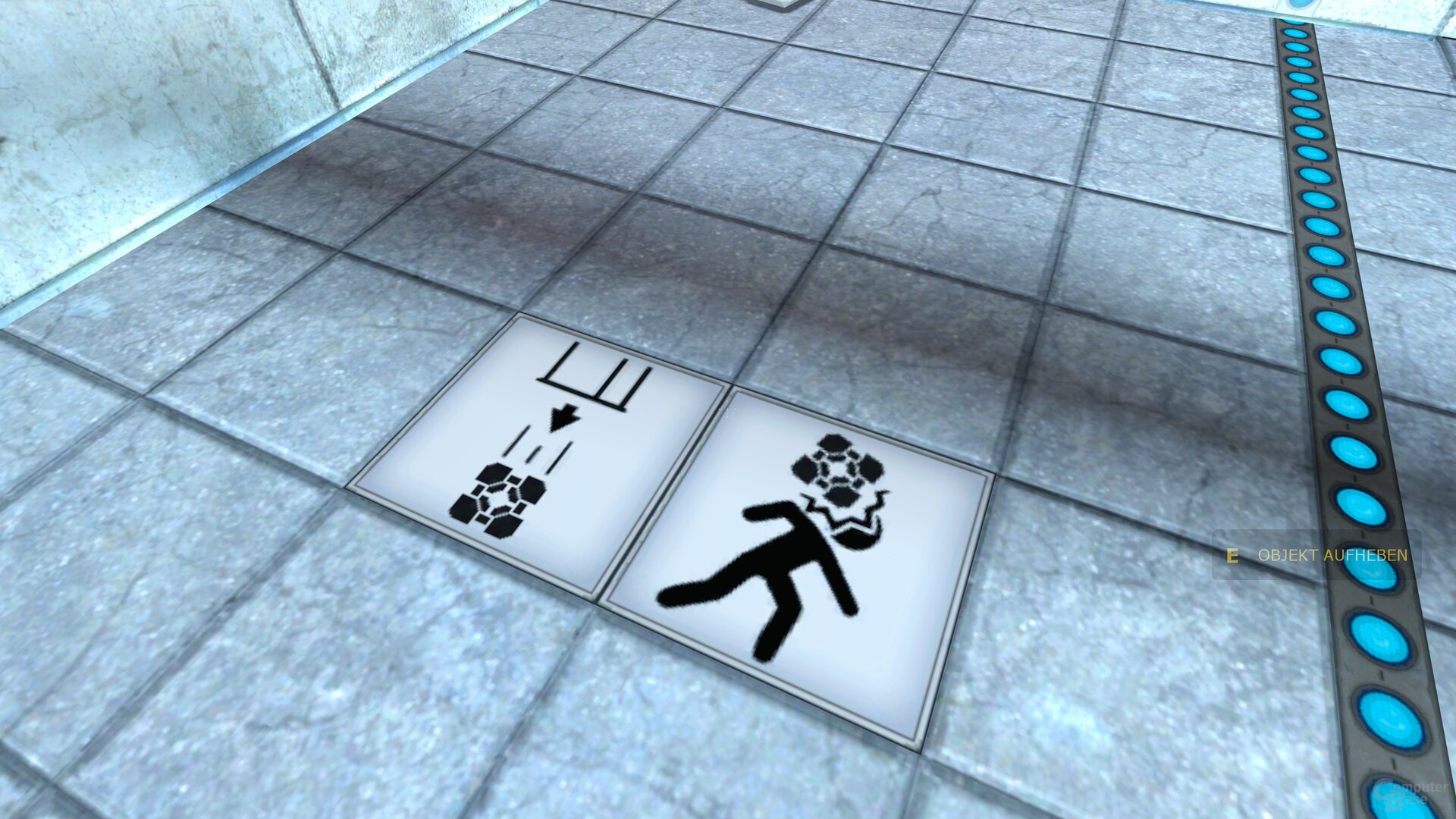 Image comparison: Portal with RTX: UHD (native resolution) ⇔ Portal Original, UHD (native resolution)
Image comparison: Portal with RTX: UHD (native resolution) ⇔ Portal Original, UHD (native resolution) The first attempts were made in the editorial office with a GeForce RTX 4080 because it was just installed in the system. At home, it should be the case for very few players at the moment. And if you want to get started with WQHD or even UHD out of habit without AI upsampling, you will be greeted by beautiful but jerky graphics even on the fastest Ampere graphics cards.
Benchmarks with and without DLSS
ComputerBase has tested Portal with RTX with selected graphics cards, an announced Day 0 patch with bug fixes has not yet been installed. The number of models used is small, but given the current workload, more was not possible – and perhaps not necessary. If there is interest in the community, this article can be expanded to include a community benchmark after the DLC has been released. The demo used should still be usable in the final version as a basis for consistent benchmarks.
- < figure class="gallery__figure">
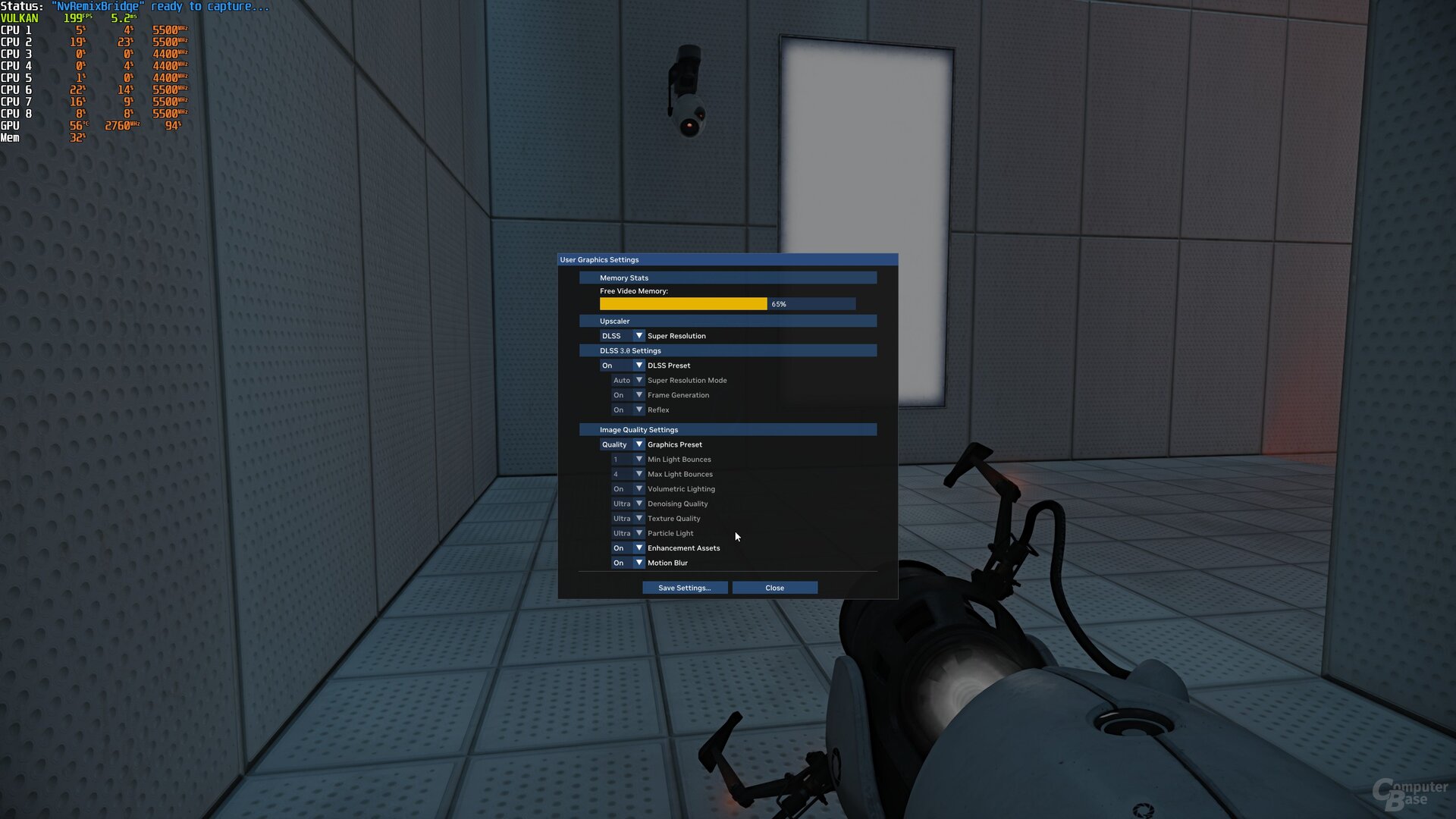 The general settings used in the benchmark
The general settings used in the benchmark
Figure 1 of 2
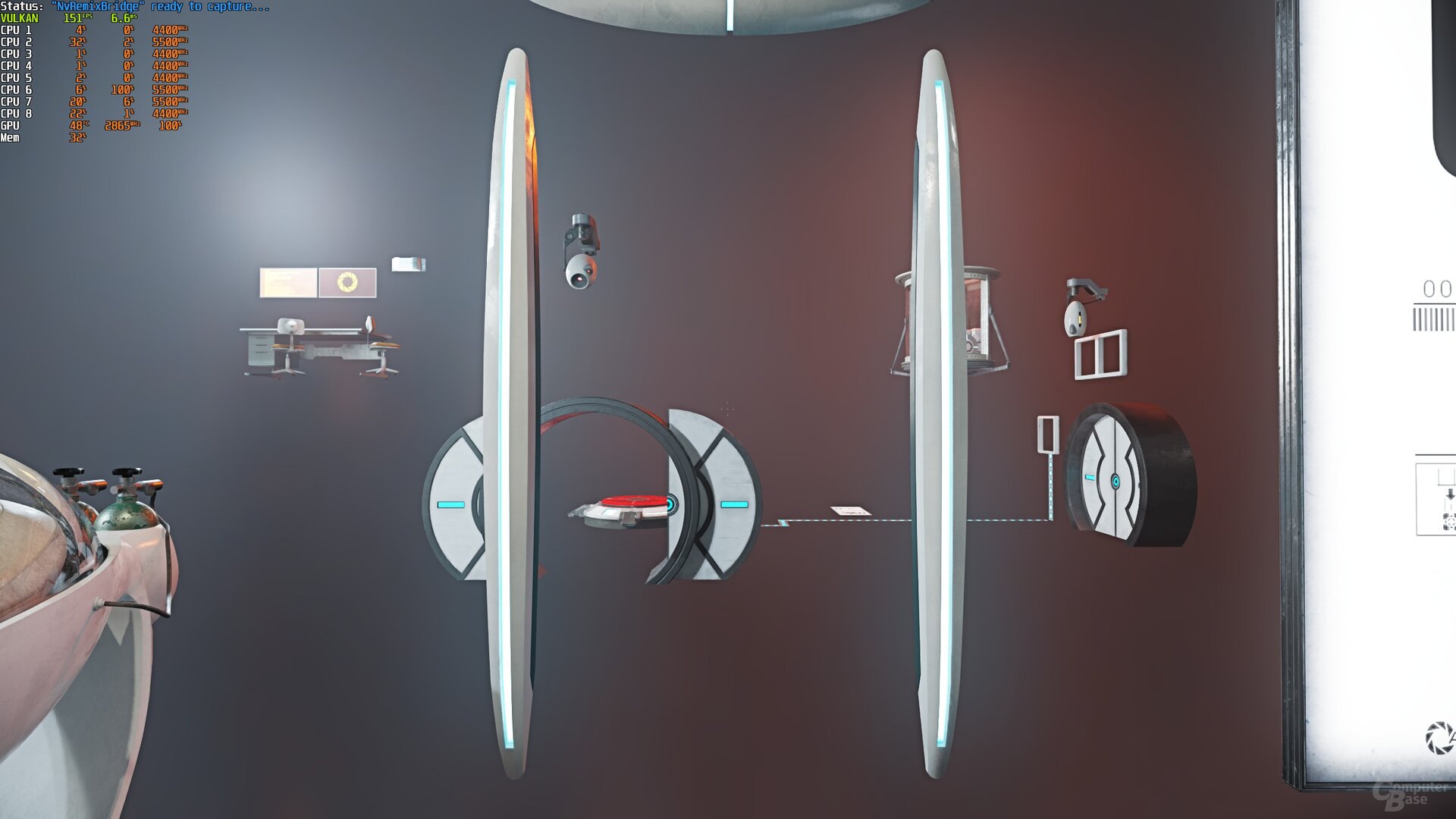 Display errors after loading a recording were the order of the day in the test, but a Day 0 patch is still to come
Display errors after loading a recording were the order of the day in the test, but a Day 0 patch is still to come
Benchmarks Portal Urversion
The original portal from 2007, which is still available on Steam today without the ray tracing DLC with DirectX 9 rendering, runs almost everywhere. The test with the 2 CU “strong” iGPU in the Ryzen 7 7700X reveals over 40 FPS in UHD, over 80 FPS in WQHD and almost 140 FPS in FHD. An RTX 4090 is around 1,000 FPS in all three resolutions, in which case the CPU and not the graphics card is the limit. The situation is different with Portal with RTX.
Benchmarks Portal RTX without DLSS
Nvidia's system requirements for Portal with RTX have not exaggerated: Portal with RTX eats GPU performance for breakfast and not too short. Even in Full HD, an RTX 3080 Ti without DLSS clearly misses the 60 FPS mark and the Turing graphics card GeForce RTX 2070 fails at 10 FPS. Apparently not a second was spent on supporting the Radeon RX 6000 with RDNA 2, because even the top model does not achieve 5 FPS in FHD.
Native resolution
- Full HD
- WQHD
- UHD
Full HD – native resolution
- FPS:
- GeForce RTX 4090
Founders Edition, 24GB97.8 - GeForce RTX 4080
MSI Suprim X, 16GB68.0 - GeForce RTX 3080 Ti
MSI Suprim X, 12GB44.3 - GeForce RTX 2070
Gigabyte Mini ITX, 8GB9.2 - Radeon RX 6900 XT
XFX Merc319, 16 GB3.6
- GeForce RTX 4090
- Frame times (1% percentile):
- GeForce RTX 4090
Founders Edition, 24 GB69,8 - GeForce RTX 4080
MSI Suprim X, 16 GB49 ,6 - GeForce RTX 3080 Ti
MSI Suprim X, 12 GB27,2 - GeForce RTX 2070
Gigabyte Mini ITX, 8 GB5,1 - Radeon RX 6900 XT
XFX Merc319, 16 GB2,2
li>
- GeForce RTX 4090
Unit: frames per second (FPS) WQHD – native resolution
- FPS:
- GeForce RTX 4090
Founders Edition, 24 GB58,3 - GeForce RTX 4080
MSI Suprim X, 16GB39.4 - GeForce RTX 3080 Ti
MSI Suprim X, 12 GB24,8 - GeForce RTX 2070
Gigabyte Mini ITX, 8 GB4,5< /li>
- GeForce RTX 4090
- Frame times (1% percentile):
- GeForce RTX 4090
Founders Edition, 24 GB41.6 - GeForce RTX 4080
MSI Suprim X, 16 GB27.7 - GeForce RTX 3080 Ti
MSI Suprim X, 12GB15.4 - GeForce RTX 2070
Gigabyte Mini ITX, 8GB2.8
- GeForce RTX 4090
Unit: Frames Per Second (FPS) UHD – Native Resolution
- FPS:
- GeForce RTX 4090
Founders Edition , 24GB26.2 - GeForce RTX 4080
MSI Suprim X, 16GB17.3 - GeForce RTX 3080 Ti
MSI Suprim X, 12GB6.9
- GeForce RTX 4090
- Frame times (1% percentile):
- GeForce RTX 4090
Founders Edition, 24 GB18.5 - GeForce RTX 4080
MSI Suprim X, 16GB12,1 - GeForce RTX 3080 Ti
MSI Suprim X, 12GB4,7
- GeForce RTX 4090
Unit: frames per second (FPS)
In higher natively rendered resolutions, Portal with RTX on the RTX 3000 is virtually unplayable, even the RTX 4080 clearly fails in WQHD at 60 FPS and the RTX 4090 in UHD at the 30 FPS hurdle. In this resolution, the GeForce RTX 3080 Ti runs out of 12 GB of graphics memory, it literally collapses.
Benchmarks with DLSS
Nvidia's solution for the very low performance of many GeForce RTX without upsampling: Portal with RTX comes with both DLSS Super Resolution (formerly DLSS 2) and DLSS Frame Generation (both marketed together as DLSS 3). There are TAA and NIS for other graphics cards, but neither of them save RDNA 2 anymore and are therefore no more than an annoying entry in the options menu.
The following screenshots show the image quality in each case in native resolution, with DLSS Super Resolution (Quality) and from the original with maximum details – each in UHD or with target resolution UHD (DLSS).
-
 Portal with RTX: UHD (native resolution)
Portal with RTX: UHD (native resolution)
Image 1 of 3
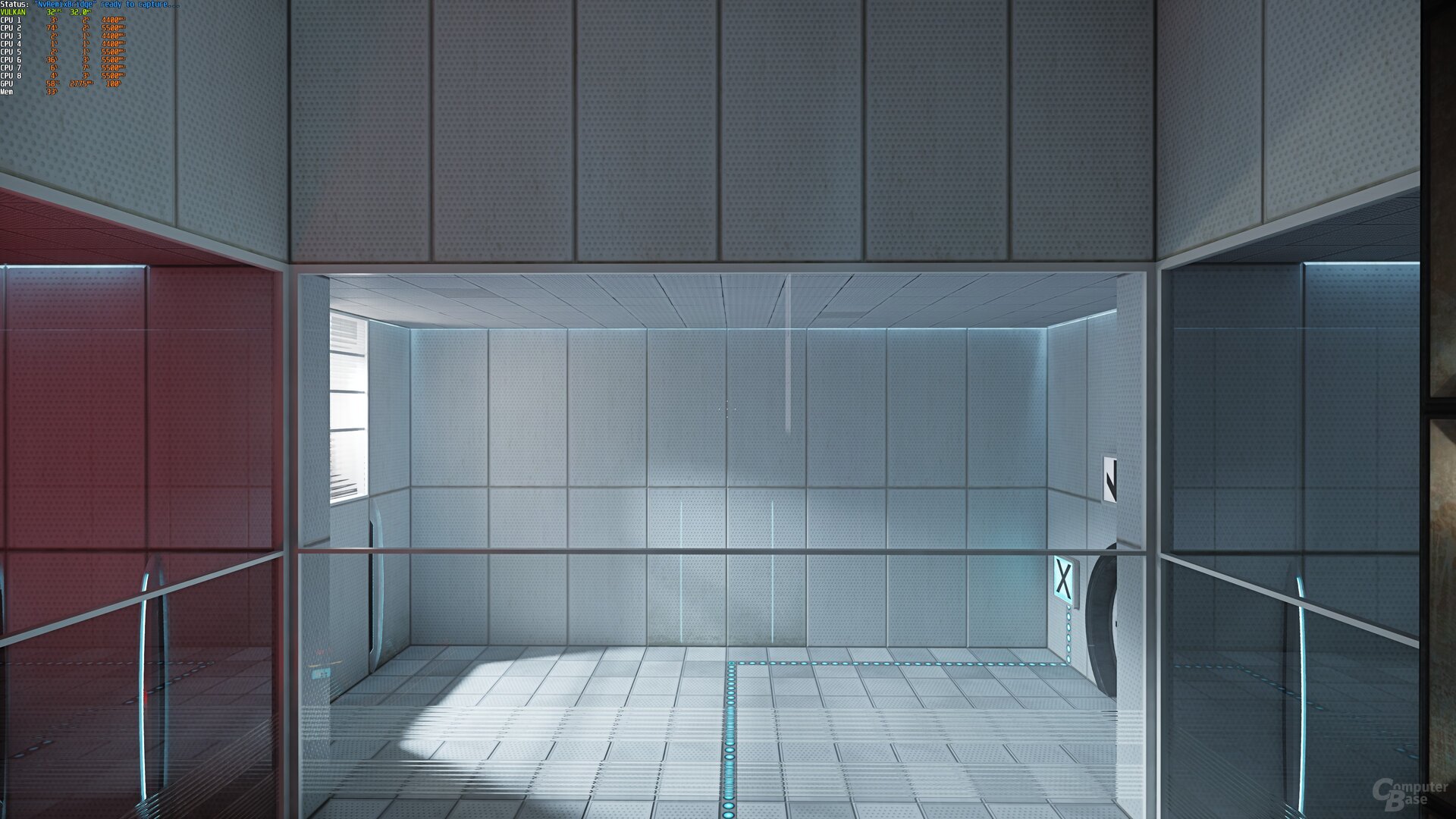 Portal with RTX: UHD (DLSS 2 Quality)
Portal with RTX: UHD (DLSS 2 Quality) Portal Original: UHD (native resolution)
Portal Original: UHD (native resolution)-
 Portal with RTX: UHD (native resolution)
Portal with RTX: UHD (native resolution)
Image 1 of 3
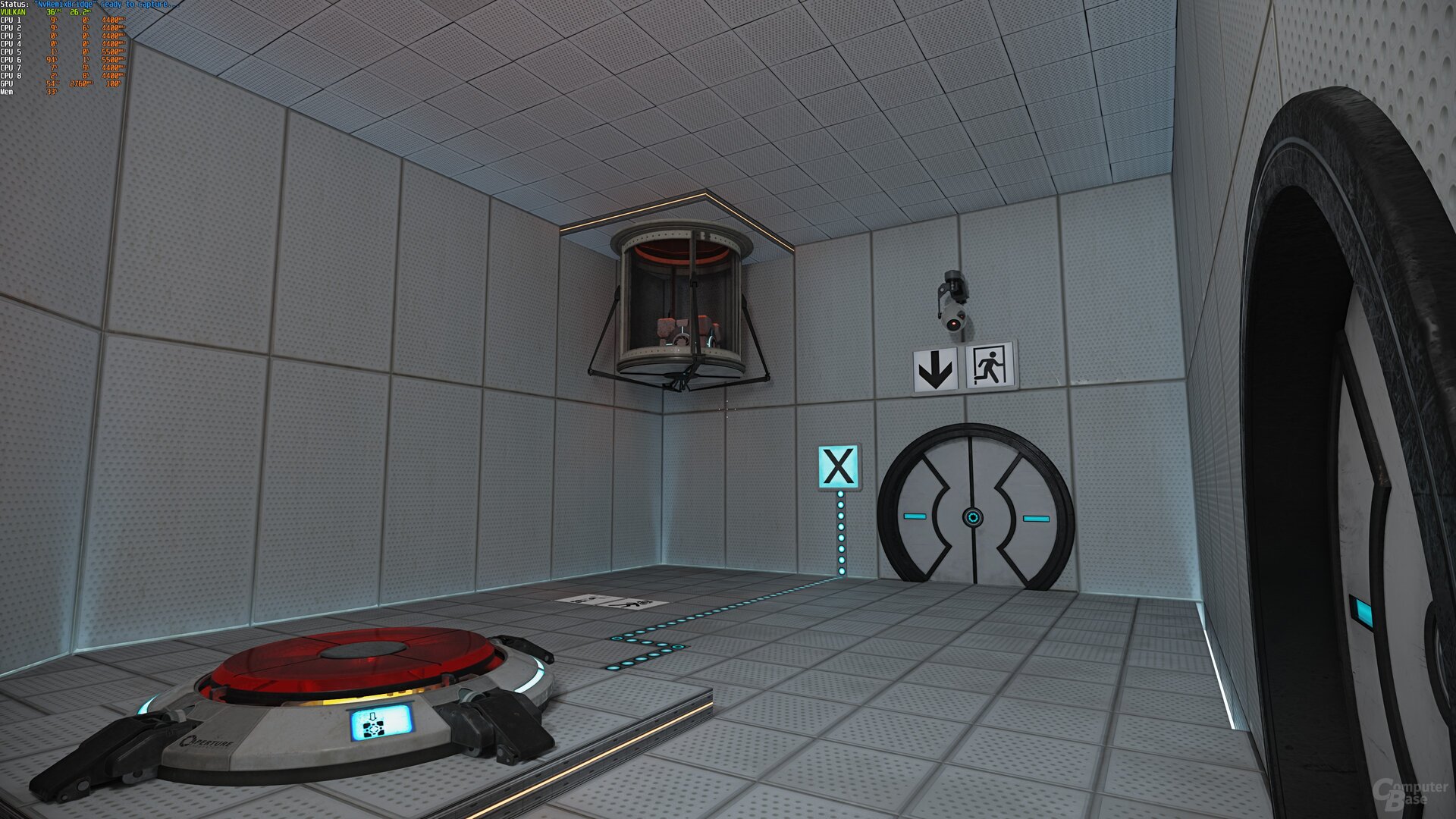 Portal with RTX: UHD (DLSS 2 Quality)
Portal with RTX: UHD (DLSS 2 Quality)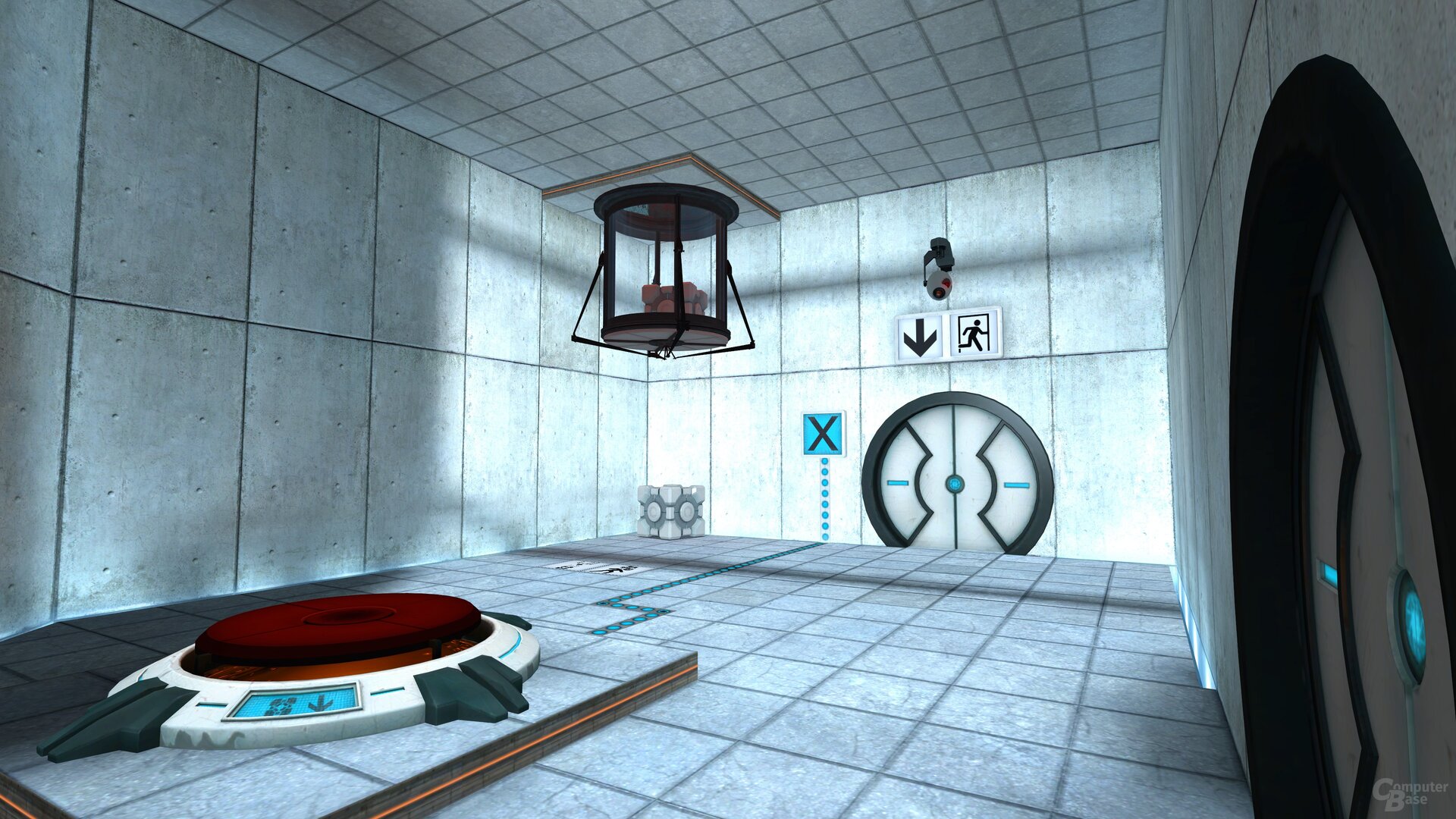 Portal Original: UHD (native resolution)
Portal Original: UHD (native resolution)- < figure class="gallery__figure">
 Portal with RTX: UHD (native resolution)
Portal with RTX: UHD (native resolution)
Figure 1 of 3
Image 1 of 3 Image 1 of 3 Image 1 of 3 Image 1 of 3 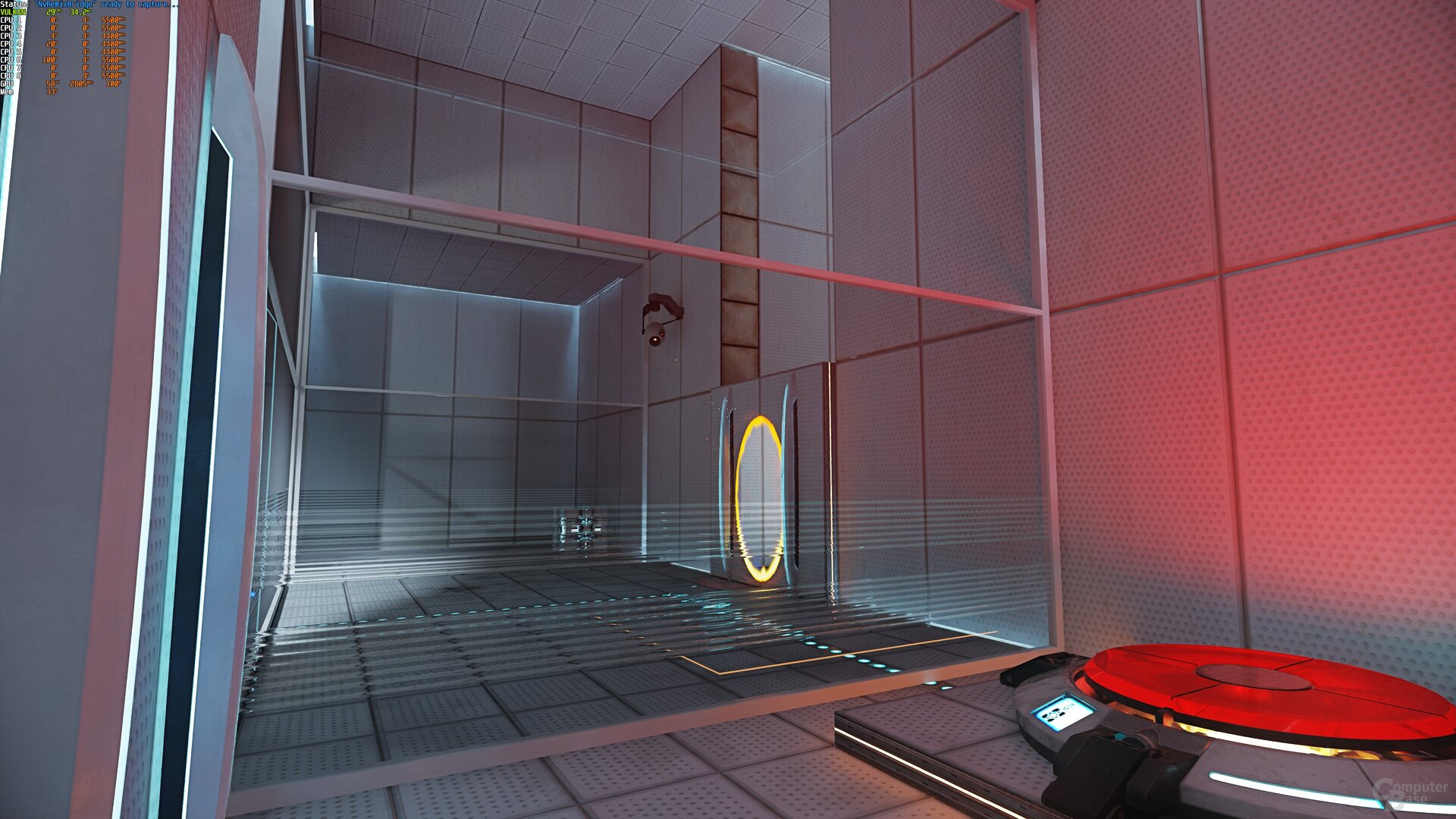 Portal with RTX: UHD (DLSS 2 Quality)
Portal with RTX: UHD (DLSS 2 Quality) Portal Original: UHD (native resolution)
Portal Original: UHD (native resolution)
 Portal with RTX: UHD (native resolution)
Portal with RTX: UHD (native resolution) 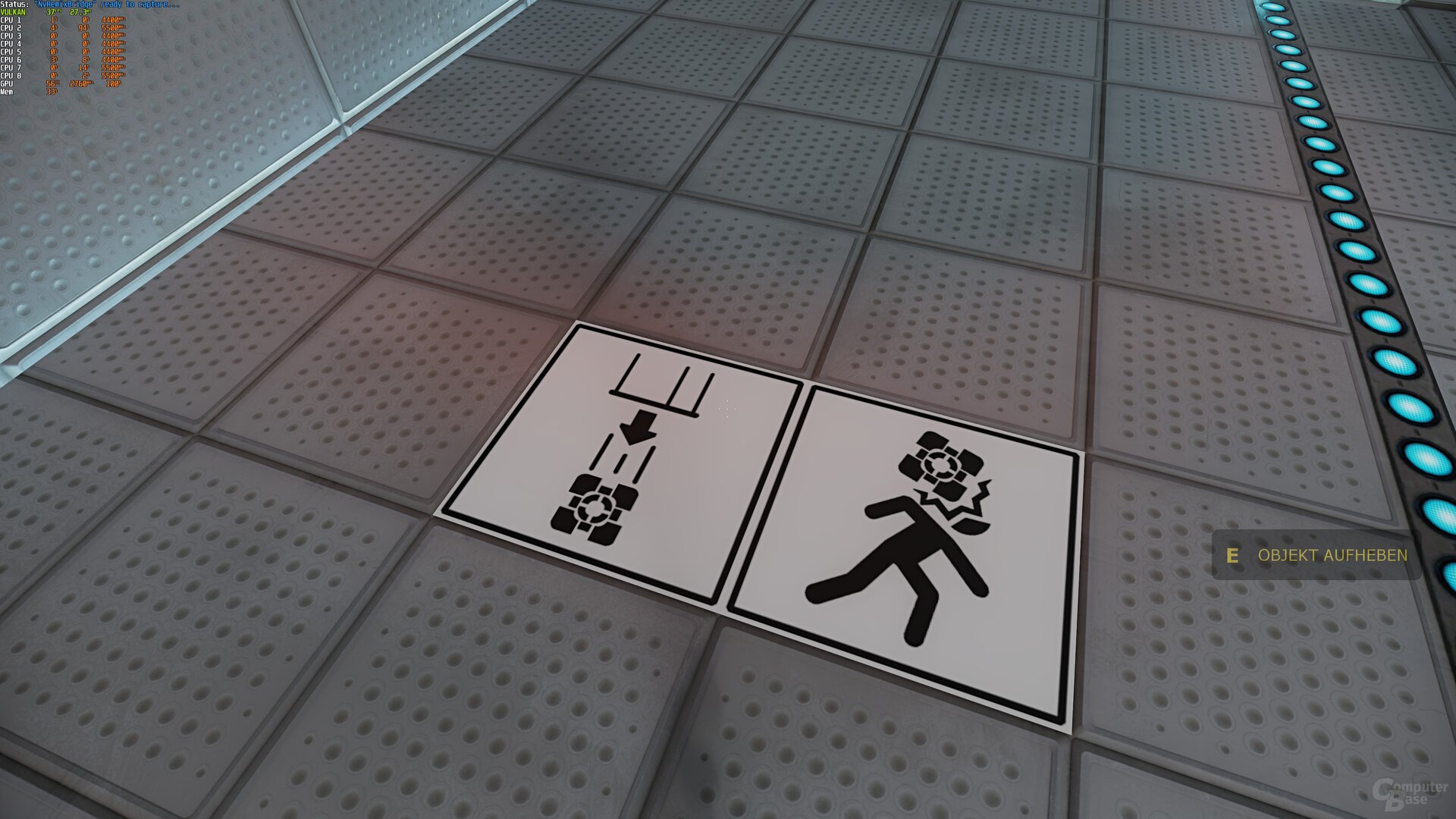 Portal with RTX: UHD (DLSS 2 Quality)
Portal with RTX: UHD (DLSS 2 Quality) Portal Original: UHD (native resolution)
Portal Original: UHD (native resolution)
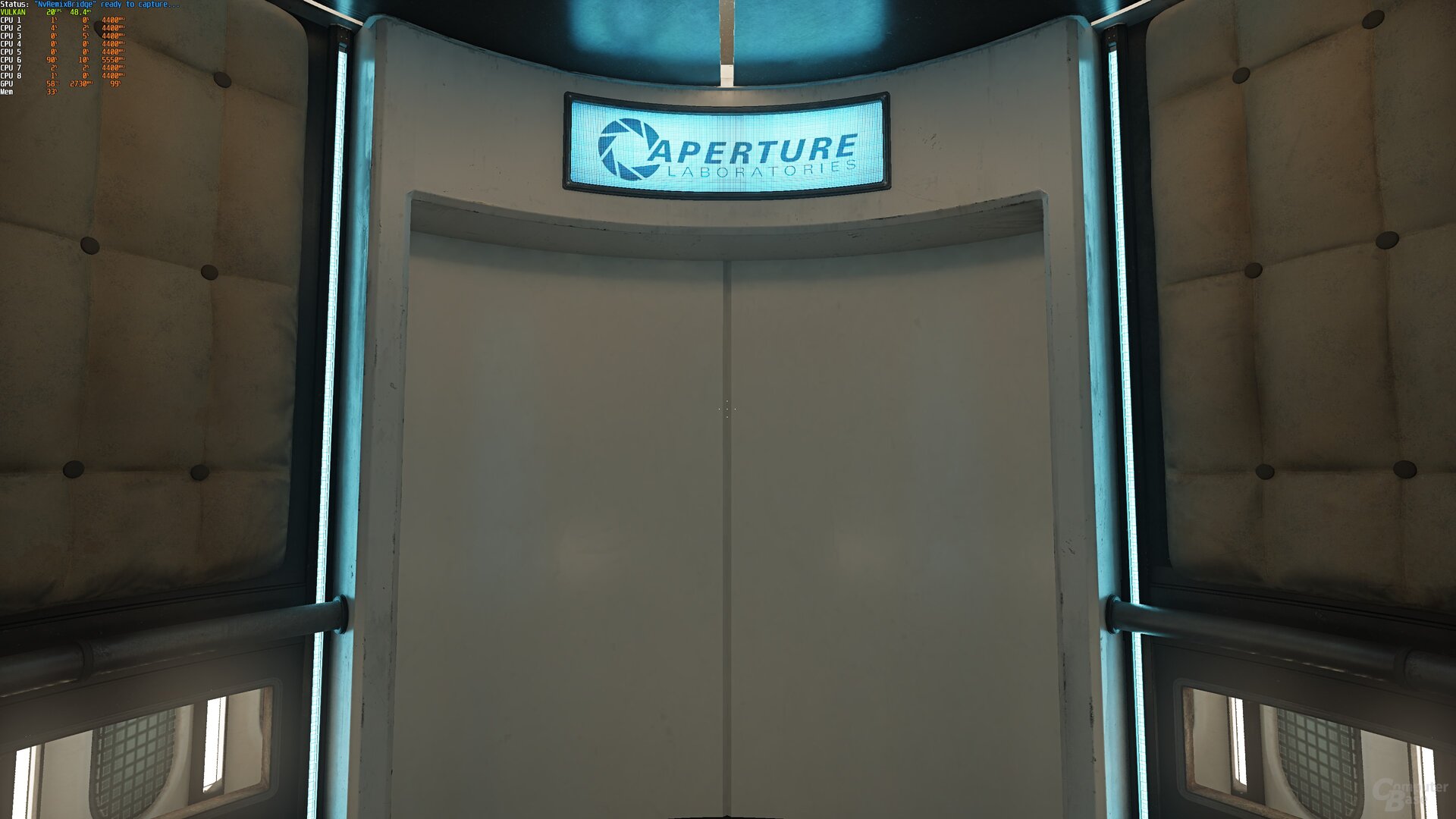 Portal with RTX: UHD (native resolution)
Portal with RTX: UHD (native resolution)  Portal with RTX: UHD (DLSS 2 Quality)
Portal with RTX: UHD (DLSS 2 Quality)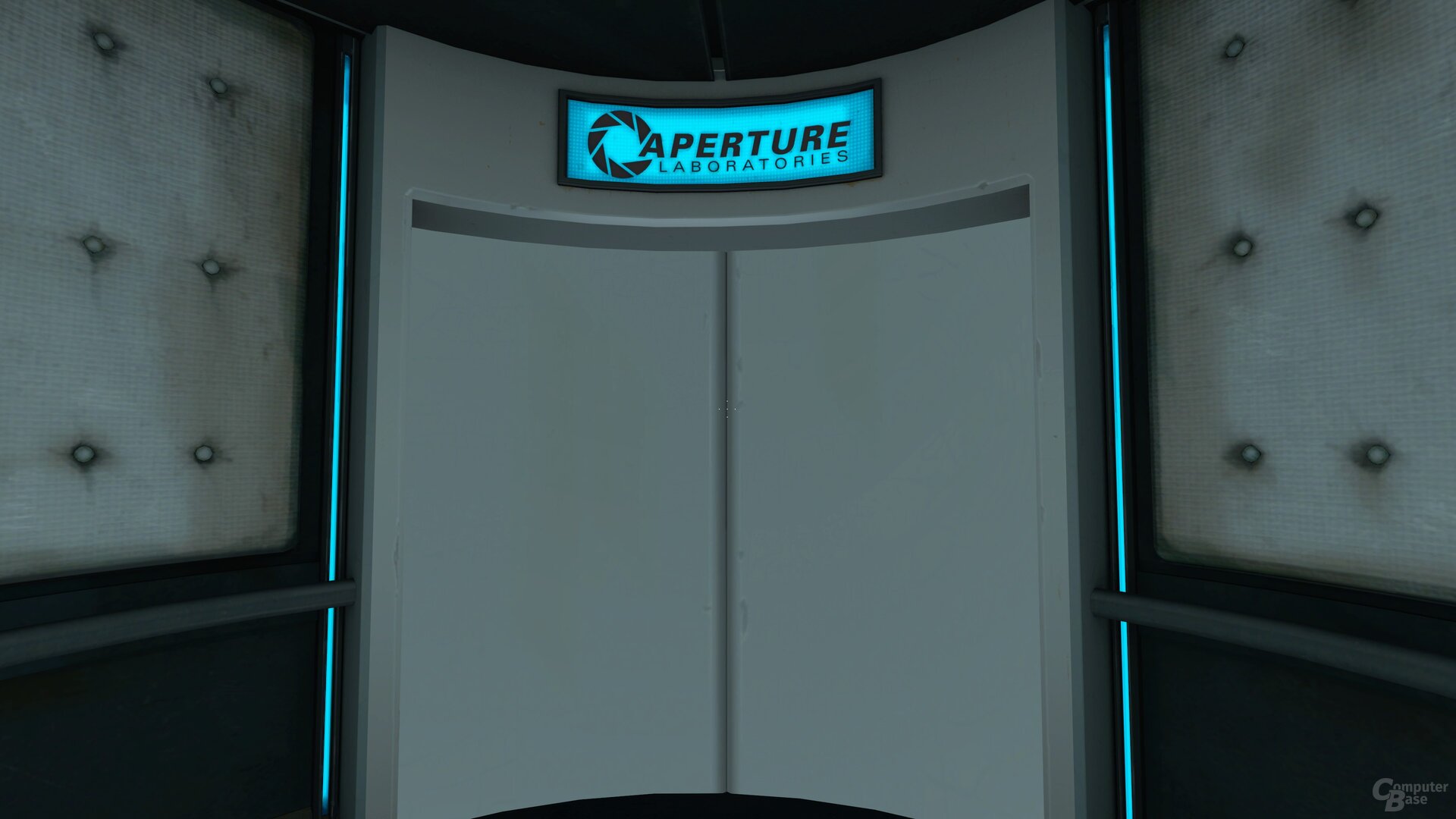 Portal Original: UHD (native resolution)
Portal Original: UHD (native resolution)
 Portal with RTX: UHD (native resolution)
Portal with RTX: UHD (native resolution) 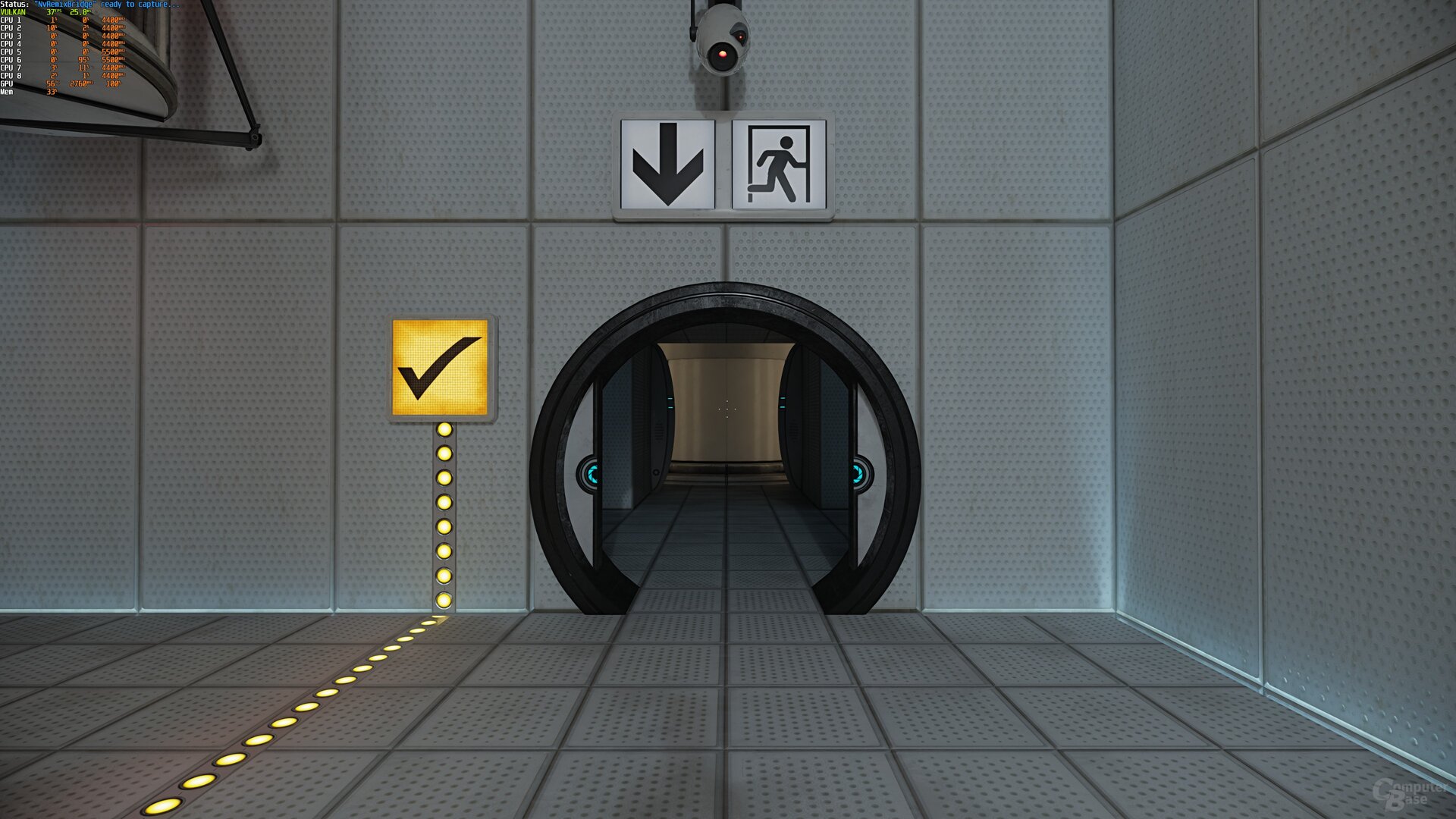 Portal with RTX: UHD (DLSS 2 Quality)
Portal with RTX: UHD (DLSS 2 Quality) Portal Original: UHD (native resolution)
Portal Original: UHD (native resolution)
 Portal with RTX: UHD (native resolution)
Portal with RTX: UHD (native resolution) 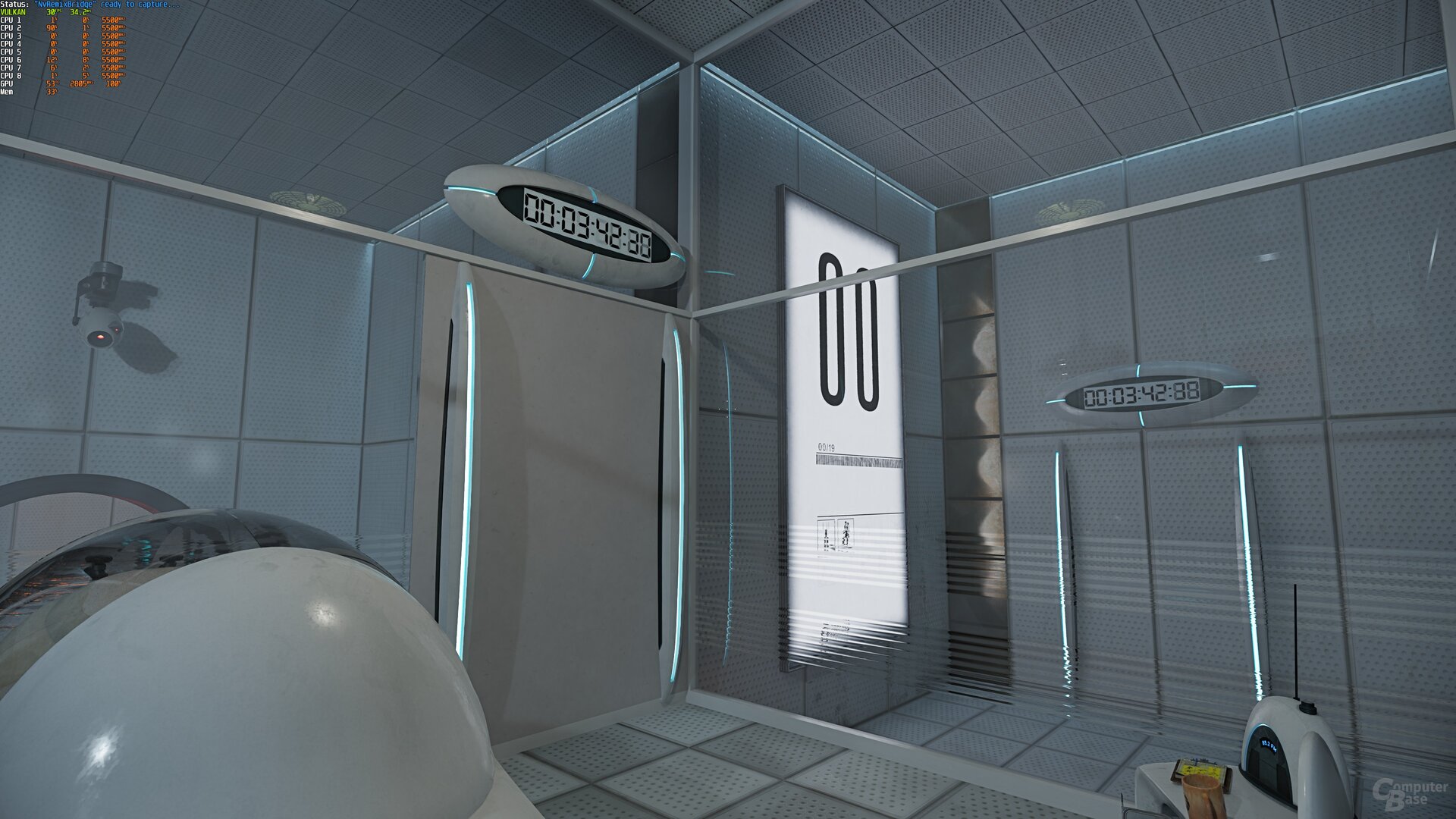 Portal with RTX: UHD (DLSS 2 Quality)
Portal with RTX: UHD (DLSS 2 Quality) Portal Original: UHD (native resolution)
Portal Original: UHD (native resolution)
DLSS is basically impressive in Portal with RTX, although the editors only took a look at DLSS Super Resolution Quality and Frame Generation. There were no serious display problems. The image stability (anti-aliasing), which looks better with DLSS Quality than with the native resolution, is significantly better. A little less opulent are halos and the refractions of light that often occur on glass panes, which DLSS seems to wash too smoothly.
DLSS 2 a.k.a. Super Resolution already increases the FPS on compatible GeForce RTX by a factor of 2, which brings the RTX 3080 Ti up to 10 percent closer to the RTX 4090 without DLSS in any resolution. The RTX 2070 does not save DLSS 2 Quality even in Full HD.
DLSS Quality
- Full HD
- WQHD
- UHD
- FPS:
- GeForce RTX 4090
Founders Edition, 24 GB170.0 - GeForce RTX 4080
MSI Suprim X, 16 GB131.0 - GeForce RTX 3080 Ti
MSI Suprim X, 12 GB86.9 - GeForce RTX 2070
Gigabyte Mini ITX, 8 GB20.6
- GeForce RTX 4090
- Frame times (1% percentile):
- GeForce RTX 4090
Founders Edition, 24 GB127.8 - GeForce RTX 4080
MSI Suprim X, 16GB96.7 - GeForce RTX 3080 Ti
MSI Suprim X, 12GB57.8 - GeForce RTX 2070
Gigabyte Mini ITX, 8 GB12,1
- GeForce RTX 4090
- FPS:
- GeForce RTX 4090
Founders Edition, 24GB110,3 - GeForce RTX 4080
MSI Suprim X, 16GB79.3 - GeForce RTX 3080 Ti
MSI Suprim X, 12GB52.1 - GeForce RTX 2070
Gigabyte Mini ITX, 8 GB11.3
- GeForce RTX 4090
- Frame times (1% percentile):
- GeForce RTX 4090
Founders Edition, 24GB83.0 - GeForce RTX 4080
MSI Suprim X, 16GB56.5 - GeForce RTX 3080 Ti
MSI Suprim X, 12GB34.1< /li> - GeForce RTX 2070
Gigabyte Mini ITX, 8 GB6,1
- GeForce RTX 4090
- FPS:
- GeForce RTX 4090
Founders Edition, 24 GB52.7 - GeForce RTX 4080
MSI Suprim X, 16GB36,6 - GeForce RTX 3080 Ti
MSI Suprim X, 12GB23,1< /li> - GeForce RTX 2070
Gigabyte Mini ITX, 8 GB4,2
- GeForce RTX 4090
- Frame times (1%- Percentile):
- GeForce RTX 4090
Founders Edition, 24 GB38.2 - GeForce RTX 4080< br>MSI Suprim X, 16GB25.7
- GeForce RTX 3080 Ti
MSI Suprim X, 12GB14.4 - GeForce RTX 2070
Gigabyte Mini ITX, 8GB2.7
< /li>
- GeForce RTX 4090
- Full HD
- WQHD
- UHD
- FPS:
- GeForce RTX 4090
Founders Edition, 24GB244.2 - GeForce RTX 4080
MSI Suprim X, 16GB195.1
- GeForce RTX 4090
- Frame times (1% percentile):
- GeForce RTX 4090
Founders Edition, 24 GB184.3 - GeForce RTX 4080
MSI Suprim X, 16GB148.4
- GeForce RTX 4090
- FPS:
- GeForce RTX 4090
Founders Edition, 24 GB167.5 - GeForce RTX 4080
MSI Suprim X, 16 GB125.8
- GeForce RTX 4090
- Frame times (1% percentile):
- GeForce RTX 4090
Founders Edition, 24 GB129.0 - GeForce RTX 4080
MSI Suprim X, 16 GB95.7
- GeForce RTX 4090
- FPS:
- GeForce RTX 4090
Founders Edition, 24 GB84.5 - GeForce RTX 4080
MSI Suprim X, 16 GB59.9
- GeForce RTX 4090
- Frame times (1% percentile):
- GeForce RTX 4090
Founders Edition, 24GB61.6 - GeForce RTX 4080
MSI Suprim X, 16GB40.4
- GeForce RTX 4090
- UHD, FPS:
- GeForce RTX 4090, SER an
Founders Edition, 24 GB26,2 - GeForce RTX 4090, SER from
Founders Edition, 24 GB23,8 - GeForce RTX 4080, SER from
MSI Suprim X, 16 GB17,3
< li class="chart__row">GeForce RTX 4080, SER off
MSI Suprim X, 16 GB15,6 - GeForce RTX 4090, SER an
- GeForce RTX 3080 Ti, SER on
MSI Suprim X, 12 GB6,9 - GeForce RTX 3080 Ti, SER off
MSI Suprim X, 12GB6,8 - QWHD, FPS:
- GeForce RTX 4090, SER on
Founders Edition, 24 GB58.3 - GeForce RTX 4090, SER on
Founders Edition, 24 GB52.4 - GeForce RTX 4080, SER on
MSI Suprim X, 16 GB39,4 - GeForce RTX 4080, SER off
MSI Suprim X, 16 GB35 ,5 - GeForce RTX 3080 Ti, SER on
MSI Suprim X, 12GB24.8 - GeForce RTX 3080 Ti, SER off
MSI Suprim X, 12GB24.8
- GeForce RTX 4090, SER on
- FHD, FPS:
- GeForce RTX 4090, SER an
Founders Edition, 24 GB97,8 - GeForce RTX 4090, SER from
Founders Edition, 24 GB87.7 - GeForce RTX 4080, SER on
MSI Suprim X, 16 GB68.0 - GeForce RTX 4080, SER from
MSI Suprim X, 16 GB61.6 - GeForce RTX 3080 Ti, SER on
MSI Suprim X, 12 GB44.3 - GeForce RTX 3080 Ti, SER off
MSI Suprim X, 12 GB44.3
- GeForce RTX 4090, SER an
< /ul>Full HD – DLSS Quality
Unit: frames per second (FPS) WQHD – DLSS Quality
Unit: frames per second (FPS) UHD – DLSS Quality
Unit: frames per second (FPS)
Nvidia GeForce RTX 4000 can also use DLSS frame generation in Portal with RTX, which makes the FPS even clearer when also cannot increase by a factor of 2. In order to keep the latency, which is not positively influenced by frame generation, as low as possible, Portal with RTX also uses Reflex.
DLSS Quality + Frame Generation
Full HD – DLSS Quality + Frame Generation
Unit: frames per second (FPS) WQHD – DLSS Quality + Frame Generation
Unit: frames per second (FPS) UHD – DLSS Quality + Frame Generation
unit : Frames per second (FPS)
Because Nvidia offers Frame Generation as a new component of DLSS 3 exclusively for Ada Lovelace – the background is said to be technical in nature – GeForce RTX 2000 and RTX 3000 are also left out in this regard.
Benchmarks with and without “SER”
In the expansive developer menu of Portal with RTX (shift + paste in the game, not in the main menu) there is an interesting option in the “Rendering” tab under “Pathtracing”: “Shader Execution Reordering “ (SER).
 The developer menu offers the option to enable and disable SER
The developer menu offers the option to enable and disable SERHiding behind this is the on/off switch for Ada Lovelace's major improvement over amps in RT hardware units. All details can be found in the article introducing the Ada Lovelace GPU generation.
In short: With active ray tracing, SER can scan the incoming rays, analyze the programs to be executed (shaders) derived from their point of occurrence and then sort them in such a way that the same shaders are always executed at the same time, even if they actually come from different rays. This should increase the utilization of the ALUs compared to the predecessor Ampere. Nvidia cited performance benefits from SER of up to 44 percent in Cyberpunk 2077 with Overdrive RT preset, up to 29 percent in Portal with RTX and up to 20 percent in Racer RTX.
RT Shader Execution Reordering (Ada Lovelace )
Unit: frames per second (FPS)
In Portal with RTX, RTX 4000 owners can now see the benefit of customization for the first time. ComputerBase has determined a good 10 percent increase in performance on both an RTX 4090 and an RT 4080, while the Ampere graphics card RTX 3080 Ti was, as expected, unimpressed by the setting.
Conclusion
Portal with RTX will be released on December 8th as free DLC for all owners of the title on Steam. That's a good thing, because very few PC owners with a GPU capable of hardware ray tracing will make more than a few attempts in this mode; the requirements are too high.
Only those who own a new GeForce RTX 4090 (test), an RTX 4080 (test) or a high-end model from the latest GeForce generation can play smoothly in Full HD without DLSS. With DLSS 2 Quality (referred to as DLSS Super Resolution Quality since the introduction of DLSS 3), this limit shifts slightly, but an RTX 3080 Ti still does not reach 60 FPS in WQHD; in UHD it is not even 25 FPS with DLSS Quality. Even the RTX 4080 and RTX 4090 only reach playable realms in high resolutions with DLSS 3, i.e. the combination of DLSS Super Resolution (“DLSS 2”) and frame generation (new with DLSS 3, exclusively on RTX 4000).
It is positive that portal harmonizes very well with DLSS Super Resolution and DLSS Frame Generation and the upscaling algorithms can therefore be activated without hesitation, at least in the tested quality setting, because and disadvantages compared to native rendering are optically balanced.
The performance of the AMD Radeon RX 6900 XT(XH) casts a shadow on Portal with RTX: It is well known that AMD's RDNA 2 generation cannot keep up with Ampere in ray tracing titles and certainly not with Ada Lovelace. But the fact that the RDNA 2 top model delivers an unplayable 3.6 FPS in Full HD and thus only almost a third of the FPS of a GeForce RTX 2070, ultimately shows once again what Portal with RTX is at its core at the end of 2022: a technology demo for owners of the fastest GeForce RTX graphics cards and not a classic that has been lovingly brought into the modern age, which should run as optimally as possible on any compatible hardware.
 Display error after loading a recording were the order of the day in the test, but a day-0 patch is yet to come
Display error after loading a recording were the order of the day in the test, but a day-0 patch is yet to comeComputerBase has been provided with access to Portal with RTX by Nvidia under NDA. The only specification was the earliest possible publication date. The manufacturer did not influence the test report, there was no obligation to publish it.
This article was interesting, helpful or both? The Editors are happy about any support from ComputerBase Pro and disabled ad blockers. More about ads on ComputerBase.